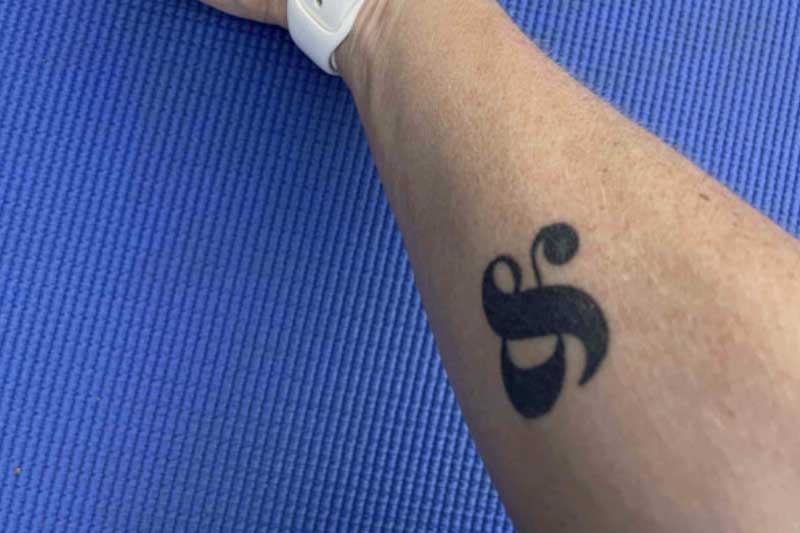
Human feelings are complex and interwoven, and often even in conflict with each other. My favorite therapeutic concept that deals with these common emotional paradoxes is “both/and.”
In the last few years, both/and has especially resonated with me: the COVID-19 pandemic shut down was both isolating and simplifying. Sitting with my beloved father as he died was both gut-wrenching and beautiful. My children are the most rewarding thing in my life, and also can drive me utterly crazy. Therapy is both painful and healing. Taking her son to college left my close friend both proud and bereft. My dog is both amazingly sweet and has a few terrible habits, hahaha.
Both/and underlies much of the work I do with people in close relationships. It seemed to particularly reach out and grab me as a clinical practice in 2020. I fell so in love with both/and that last year I got an ampersand tattoo. It seemed fitting, given the degree that this concept has become a guiding principle for me both personally and professionally. The tattoo on the inside of my forearm serves both as a grounding reminder for me and a convenient show-and-tell piece for clients who might also find comfort in the practice of both/and thinking.
In human relationships, secure attachments necessitate being a whole, separate individual while also being deeply connected to another person. Thus, there is always tension between individuality and togetherness. In intimate relationships we have to contend with dual fears: the fear of rejection, and the fear of becoming so enmeshed we lose ourselves. We must navigate a path between these fears to experience a truly close bond. Rather mind boggling, isn’t it?! The challenges presented by this tension are what drive so many people in relationships into therapy.
Many times I’m sitting with a couple and one member is expressing their pain in a way that makes it really difficult for their partner to move toward them, or experience empathy for them, because they are throwing emotional darts. My power as a therapist lies in my ability to hold both experiences – empathy for the partner being criticized, and empathy for the partner whose anger is usually a surface reaction driven by some deeper pain or fear. My clients trust me to decode these confusing, often excruciating emotional moments, based on my personal curiosity about the complex nuances within human emotions.
Something I hear myself saying indirectly or even directly quite often in therapy is that there can be enough room in a relationship for seemingly competing or contrasting feelings. For example, if one person is expressing their fear about being disappointed by their partner on their birthday, the other person might feel offended that their partner doesn’t trust them to deliver, or is seeing them as having failed before being given a chance. A successful resolution of this emotional conundrum means allowing enough “space” in the moment between these two people for both emotional experiences to be valid, expressed, and empathized with. With vulnerable expression of pain, fear and longing, people can typically find their way towards a closer connection.
Another manner in which both/and often presents itself is found in the ways people attempt to repair conflicts through apologies. People start out strong with many of the right components: “I am so sorry that I hurt you…” and “I was wrong when I…” However, they don’t put a period at the end of those statements of acknowledgement and remorse. I swear I can almost feel my body tensing when I sense the energy of a “BUT” about to be tagged onto an otherwise meaningful apology. That is the most sure-fire way to negate everything you just said. If I know a client pretty well, sometimes I’ll even get playful and interrupt them before they finish the “but” with the sound I used frequently when my kids were little and about to wander off: “Bup Bup Bup!!! Stop right there! No BUTS!”
In the absence of the “but,” the apology is given cleanly and clearly to the recipient. Ideally an apology ends right after the acknowledgment of the hurt and there is space for the hurt party to receive and respond. If there is anything else said, it should be in the spirit of an AND. The and in this sort of apology is the implied unconditionality. For example, “I am so sorry my actions hurt you AND I truly didn’t consider how my statement was going to land with you. I am going to do better in the future.” AND energy feels very different in our nervous systems than conditional, defensive BUT energy.
I’ll often encourage my clients to practice being in the spirit of BOTH/AND by replacing each spoken and written “but” with an “and.” It really changes the tone and meaning of your expressions. Try this as a creative experiment: play around with both/and in your own life. Get curious about how it can change your tone, approach, and overall capacity to love with the depth and complexity that makes us human.